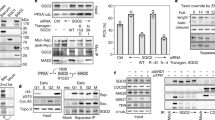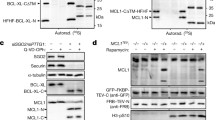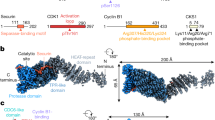Abstract
The cysteine protease separase triggers anaphase onset by cleaving chromosome-bound cohesin. In humans, separase also cleaves itself at multiple sites, but the biological significance of this reaction has been elusive. Here we show that preventing separase auto-cleavage, via targeted mutagenesis of the endogenous hSeparase locus in somatic cells, interferes with entry into and progression through mitosis. The initial delay in mitotic entry was not dependent on the G2 DNA damage checkpoint, but rather involved improper stabilization of the mitosis-inhibiting kinase Wee1. During M phase, cells deficient in separase auto-cleavage exhibited striking defects in spindle assembly and metaphase chromosome alignment, revealing an additional early mitotic function for separase. Both the G2 and M phase phenotypes could be recapitulated by separase RNA interference and corrected by re-expressing wild-type separase in trans. We conclude that separase auto-cleavage coordinates multiple aspects of the G2/M programme in human cells, thus contributing to the timing and efficiency of chromosome segregation.
This is a preview of subscription content, access via your institution
Access options
Subscribe to this journal
Receive 12 print issues and online access
$209.00 per year
only $17.42 per issue
Buy this article
- Purchase on Springer Link
- Instant access to full article PDF
Prices may be subject to local taxes which are calculated during checkout





Similar content being viewed by others
References
Lengauer, C., Kinzler, K. W. & Vogelstein, B. Genetic instabilities in human cancers. Nature 396, 643–649 (1998).
Nasmyth, K. Segregating sister genomes: the molecular biology of chromosome separation. Science 297, 559–565 (2002).
Uhlmann, F., Wernic, D., Poupart, M. A., Koonin, E. V. & Nasmyth, K. Cleavage of cohesin by the CD clan protease separin triggers anaphase in yeast. Cell 103, 375–386 (2000).
Herzig, A., Lehner, C. F. & Heidmann, S. Proteolytic cleavage of the THR subunit during anaphase limits Drosophila separase function. Genes Dev. 16, 2443–2454 (2002).
Waizenegger, I., Gimenez-Abian, J., Wernic, D. & Peters, J. Regulation of human separase by securin binding and autocleavage. Curr. Biol. 12, 1368–1378 (2002).
Zou, H., Stemman, O., Anderson, J. S., Mann, M. & Kirschner, M. W. Anaphase specific auto-cleavage of separase. FEBS Lett. 528, 246–250 (2002).
Chestukhin, A., Pfeffer, C., Milligan, S., DeCaprio, J. A. & Pellman, D. Processing, localization, and requirement of human separase for normal anaphase progression. Proc. Natl Acad. Sci. USA 100, 4574–4579 (2003).
Jallepalli, P. V. et al. Securin is required for chromosomal stability in human cells. Cell 105, 445–457 (2001).
Hirata, R., Chamberlain, J., Dong, R. & Russell, D. W. Targeted transgene insertion into human chromosomes by adeno-associated virus vectors. Nature Biotechnol. 20, 735–738 (2002).
Kohli, M., Rago, C., Lengauer, C., Kinzler, K. W. & Vogelstein, B. Facile methods for generating human somatic cell gene knockouts using recombinant adeno-associated viruses. Nucleic Acids Res. 32, e3 (2004).
Nagao, K., Adachi, Y. & Yanagida, M. Separase-mediated cleavage of cohesin at interphase is required for DNA repair. Nature 430, 1044–1048 (2004).
Gould, K. L. & Nurse, P. Tyrosine phosphorylation of the fission yeast cdc2+ protein kinase regulates entry into mitosis. Nature 342, 39–45 (1989).
Watanabe, N. et al. M-phase kinases induce phospho-dependent ubiquitination of somatic Wee1 by SCFβ-TrCP. Proc. Natl Acad. Sci. USA 101, 4419–4424 (2004).
Peng, C. Y. et al. Mitotic and G2 checkpoint control: regulation of 14-3-3 protein binding by phosphorylation of Cdc25C on serine-216. Science 277, 1501–1505 (1997).
Gray, N. S. et al. Exploiting chemical libraries, structure, and genomics in the search for kinase inhibitors. Science 281, 533–538 (1998).
Blangy, A. et al. Phosphorylation by p34cdc2 regulates spindle association of human Eg5, a kinesin-related motor essential for bipolar spindle formation in vivo. Cell 83, 1159–1169 (1995).
Compton, D. A. & Luo, C. Mutation of the predicted p34cdc2 phosphorylation sites in NuMA impair the assembly of the mitotic spindle and block mitosis. J. Cell Sci. 108, 621–633 (1995).
Mishima, M., Pavicic, V., Gruneberg, U., Nigg, E. A. & Glotzer, M. Cell cycle regulation of central spindle assembly. Nature 430, 908–913 (2004).
van Vugt, M. A. et al. Polo-like kinase-1 is required for bipolar spindle formation but is dispensable for anaphase promoting complex/Cdc20 activation and initiation of cytokinesis. J. Biol. Chem. 279, 36841–36854 (2004).
Sumara, I. et al. Roles of Polo-like kinase 1 in the assembly of functional mitotic spindles. Curr. Biol. 14, 1712–1722 (2004).
Hirota, T. et al. Aurora-A and an interacting activator, the LIM protein Ajuba, are required for mitotic commitment in human cells. Cell 114, 585–598 (2003).
Lampson, M. A. & Kapoor, T. M. The human mitotic checkpoint protein BubR1 regulates chromosome-spindle attachments. Nature Cell Biol. 7, 93–98 (2005).
Stegmeier, F., Visintin, R. & Amon, A. Separase, polo kinase, the kinetochore protein Slk19, and Spo12 function in a network that controls Cdc14 localization during early anaphase. Cell 108, 207–220 (2002).
Sullivan, M. & Uhlmann, F. A non-proteolytic function of separase links the onset of anaphase to mitotic exit. Nature Cell Biol. 5, 249–254 (2003).
Pereira, G. & Schiebel, E. Separase regulates INCENP-Aurora B anaphase spindle function through Cdc14. Science 302, 2120–2124 (2003).
Ross, K. E. & Cohen-Fix, O. A Role for the FEAR pathway in nuclear positioning during anaphase. Dev. Cell 6, 729–735 (2004).
Viadiu, H., Stemmann, O., Kirschner, M. W. & Walz, T. Domain structure of separase and its binding to securin as determined by EM. Nature Struct. Mol. Biol. 12, 552–553 (2005).
Gorr, I. H., Boos, D. & Stemmann, O. Mutual inhibition of separase and cdk1 by two-step complex formation. Mol. Cell 19, 135–141 (2005).
Zou, H., McGarry, T. J., Bernal, T. & Kirschner, M. W. Identification of a vertebrate sister-chromatid separation inhibitor involved in transformation and tumorigenesis. Science 285, 418–422 (1999).
Stemmann, O., Zou, H., Gerber, S. A., Gygi, S. P. & Kirschner, M. W. Dual inhibition of sister chromatid separation at metaphase. Cell 107, 715–726 (2001).
Pei, L. & Melmed, S. Isolation and characterization of a pituitary tumor-transforming gene (PTTG). Mol. Endocrinol. 11, 433–441 (1997).
Ramaswamy, S., Ross, K. N., Lander, E. S. & Golub, T. R. A molecular signature of metastasis in primary solid tumors. Nature Genet. 33, 49–54 (2003).
Hauf, S. et al. The small molecule Hesperadin reveals a role for Aurora B in correcting kinetochore-microtubule attachment and in maintaining the spindle assembly checkpoint. J. Cell Biol. 161, 281–294 (2003).
Kanda, T., Sullivan, K. F. & Wahl, G. M. Histone-GFP fusion protein enables sensitive analysis of chromosome dynamics in living mammalian cells. Curr. Biol. 8, 377–385 (1998).
Lengauer, C., Kinzler, K. W. & Vogelstein, B. DNA methylation and genetic instability in colorectal cancer cells. Proc. Natl Acad. Sci. USA 94, 2545–2550 (1997).
Acknowledgements
The authors thank A. Chestukhin for providing the XJ11-1B12 antibody and F. Weis-Garcia for expert assistance with hybridoma screening and monoclonal antibody production. M.P. was supported through an American-Italian Cancer Foundation postdoctoral fellowship. Additional support was provided to P.V.J. by the Pew Scholars Program in the Biomedical Sciences, the V Foundation for Cancer Research, and the National Cancer Institute, National Institutes of Health.
Author information
Authors and Affiliations
Ethics declarations
Competing interests
The authors declare no competing financial interests.
Supplementary information
Supplementary Information
Supplementary figures S1 and S2 plus movie legends (PDF 160 kb)
Rights and permissions
About this article
Cite this article
Papi, M., Berdougo, E., Randall, C. et al. Multiple roles for separase auto-cleavage during the G2/M transition. Nat Cell Biol 7, 1029–1035 (2005). https://doi.org/10.1038/ncb1303
Received:
Accepted:
Published:
Issue Date:
DOI: https://doi.org/10.1038/ncb1303
This article is cited by
-
Conservation of the separase regulatory domain
Biology Direct (2018)
-
A stringent requirement for Plk1 T210 phosphorylation during K-fiber assembly and chromosome congression
Chromosoma (2012)
-
Cohesin acetylation speeds the replication fork
Nature (2009)
-
Genetic knockouts and knockins in human somatic cells
Nature Protocols (2007)
-
More than a separase
Nature Cell Biology (2005)



